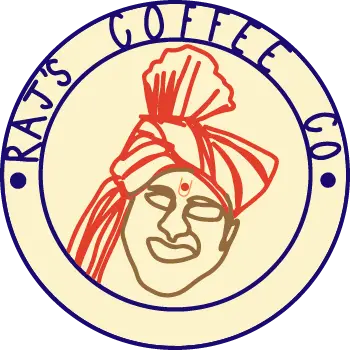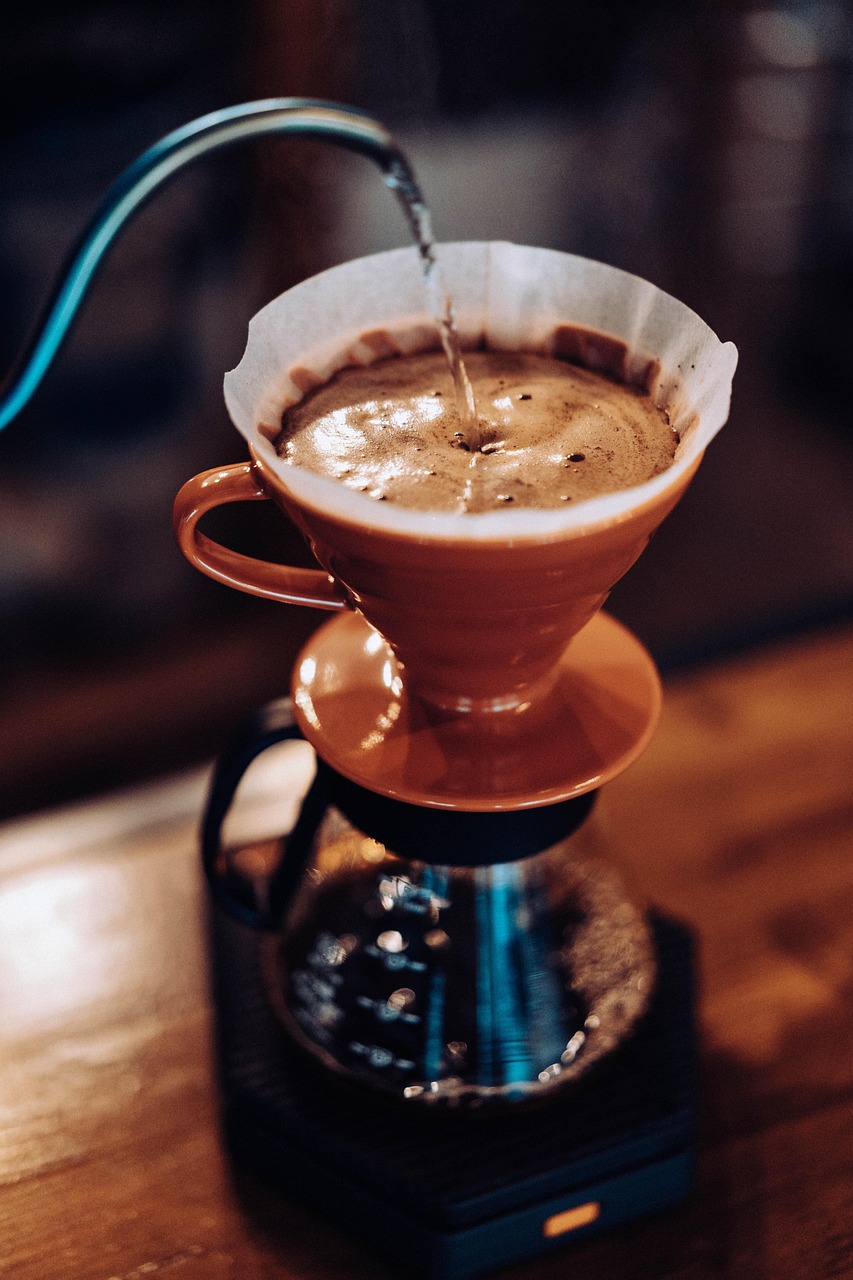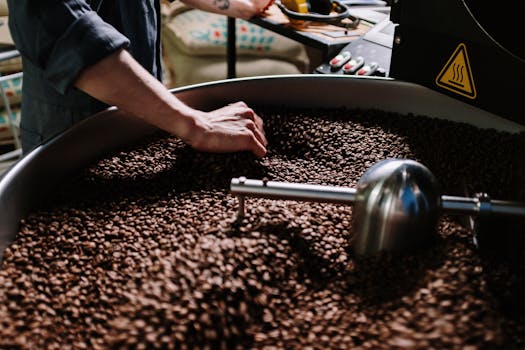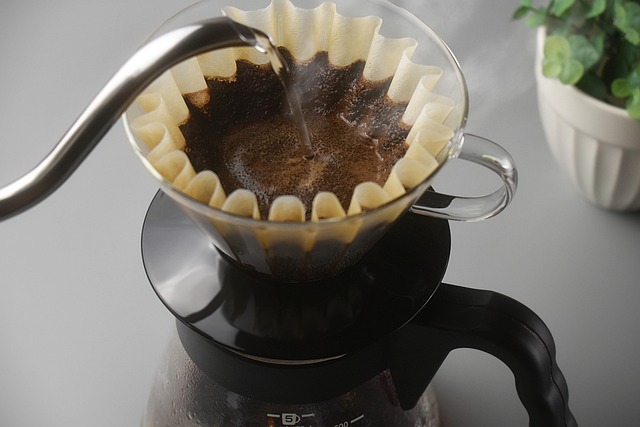At Raj’s Coffee, we believe that brewing great coffee at home has never been easier. It only takes a few simple steps to upgrade the quality of your cup. We’ve covered some of those steps here on this blog! But we also know that for a lot of home coffee enthusiasts, there is always more room to improve. We always love learning more about how to get great flavors in our coffee. And one of the underrated areas of focus for home brewers is the relationship between roast level and water temperature.
The way that roasting affects brewing at home is multifaceted, and the whole subject would take up much more than just one article. But here, we’d like to zero in on one specific part of that relationship. Simply put, the roast level of your coffee beans should determine the temperature of the water you use.
We’re going to spend this particle unpacking why that is. We’ll dive a little bit into the science of the roasting process. From there, we’ll talk about solubility and extraction and how those change based on roast level. Finally, we’ll come back to what all this means for your home brewing.
Quick note: some of what we’ll cover here can also be found in our article on the best coffee roasts for you.
The Roasting Process
In order for coffee beans to yield flavor, they must be roasted. The un-roasted green coffee bean is hard and insoluble. It would be very difficult to extract any flavor from the bean in this state. The roasting process opens up the flavor by making the bean more soluble and brittle. A roasted bean is an excellent vessel to deliver the flavors of coffee we all love so much.
Roasters play with two main factors: time and temperature. For each batch of beans they source, a roaster must determine how long the beans should spend in the roaster and how hot the roaster should be. The flavor of coffee beans changes depending how long and how hot they’re roasted.
There are a number of chemical reactions that occur that cause this flavor change to happen. As we mentioned in our previous post on coffee roasting, the two main reactions are the rendering of oils and the caramelization of sugars. Both of these change the appearance and flavor of the coffee, making beans more aromatic, acidic, and up to a point, sweet. These reactions also darken the color of the beans. Darker roasted beans even take on an oily, shiny texture.
Roast Levels
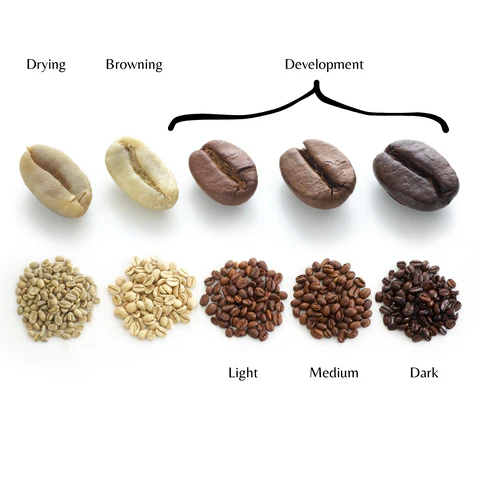
Generally speaking, there are three categories of roast level: light, medium, and dark. A light roast is paler in color and yields more natural, acidic flavors. In other words, the flavor of a light roast reflects its origin more so than other roasts. A dark roast is, aptly, quite dark in color, sometimes even blackened. The flavor of a dark roast will reflect the roasting process more so than other roasts. In between these two ends of the spectrum are light-medium, medium, and medium-dark. Each of these terms describes the character of flavor you should expect from the coffee.
An important point to know about roast levels is that there is not a universal measuring system for determining what is light, dark, or in between. There are common characteristics of roasted beans that can be, and usually are, grouped into the categories of light, medium, dark, etc. But there is no single method of categorization. This is why some roasters prefer not to categorize in terms of “roast character.” In other words, they consider the combination of time and temperature a batch of beans needs to achieve the desired flavors.
That being said, the categories of light, medium, and dark are still a useful shorthand, especially when it comes to buying coffee. You will notice that the product we offer at Raj’s Coffee includes roast levels. That’s because we know that different coffee drinkers have different flavor preferences, and we want to help you determine which ones you’ll like most! (Okay, the shameless plug is over.)
Solubility
We need to talk about solubility for just a bit. Like we said, green un-roasted coffee beans are pretty insoluble. Even if you poured extremely hot water on them for an extended period of time, you would still get hot water, albeit a slightly vegetal tasting hot water. The longer and hotter a coffee bean is roasted, the more soluble it becomes. In other words, once roasted, water more easily dissolves the contents of the bean – grounds – to become the coffee you drink.
This means that light roasted coffee beans are not as soluble as dark roasted coffee beans. Darker roasts yield more easily to water than lighter roasts do, and this has a big impact on how to brew the coffee once the beans are roasted.
Extraction & Flavor
All brewing methods require the introduction of water to the coffee grounds. But the temperature of the water has a clear impact on the effectiveness of water to draw out flavor. The hotter the water, the more easily it will extract flavor. Before you get to thinking that you need to always then have really hot water, keep in mind the following mechanics of the extraction process.
Water extracts different flavors at different stages of extraction. Early on, you get a lot of fruity acids, which provide fruity and floral aromas as well as acidity. You then start getting flavors related to the roasting process, like browning sugars and caramels. Eventually, water starts yielding dry distillates. These are more common in darker roasts and give coffee a bitter and burnt flavor.
What this means for you is that there is a balance in extraction. A good cup of coffee has the right balance of all of these compounds, as none of them would taste good on their own. A coffee that has too much of one over the others brings unpleasant flavors. An under-extracted coffee, which will be heavy on fruity acids, will taste thin and sour, while an over-extracted coffee, which will feature a lot of dry distillates, will taste bitter, astringent, and burnt.
The Takeaway
So, what does all this mean? Well, a dark roast brewed at high temperature – let’s say 205 degrees Fahrenheit – will yield a lot of unpleasant flavors that will dominate the cup. The water has been too effective at extracting flavor and you will end up with a cup that is out of balance. If you brew at this temperature with a light roast, however, the water will have needed that higher heat to penetrate the grounds, and your cup will be balanced.
Conversely, a light roast brewed at low temperature won’t yield as many flavor compounds as you want. The water won’t have been effective enough, and you will have an unbalanced cup of a different sort. But a dark roast at low temperature is likely to be more balanced.
All this is to say, if you want to up your home brewing game, consider brewing dark roasts at lower temperature and light roasts at higher temperature.
Temperature Range
For a more specific range of temperature, we think that the guide found in James Hoffmann’s How to Make the Best Coffee at Home (94) does an excellent job. (You can find this book here.) Here is our re-printing of that guide.
Very light roasts: 95–100°C (203–212°F)
Light roasts: 92–100°C (198–212°F)
Medium roasts: 85–95°C (185–203°F)
Medium-dark roasts: 80–90°C (176–194°F)
Dark roasts: 80–85°C (176–185°F)
As far as measuring your temperature, a simple thermometer will do the trick just fine. But if you’re in the market for a kettle that can read temperature for you, it’s hard to do better than the Fellow Stagg EKG, which has a temperature gauge on the corner. Other electric kettles with temperature readers can also be found pretty easily.
Consider this a starting point for your own recipes. Certainly you may find that going outside of these temperature ranges works for you. Follow your tastes!
Conclusion
Ultimately, all of this nerding out about coffee is in service to the search for great coffee. We believe that considering things like roast level and water temperature helps us on that search. Regardless of your preferences for flavor or brewing method, we hope there is something here that will help you too. Happy brewing!
